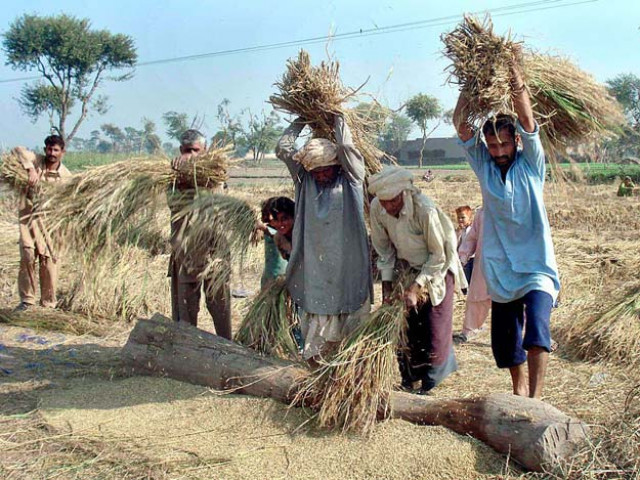Case for agriculture tax
Studies indicate that direct tax would help exchequer

Farmers have been asking the government to subsidise the agriculture sector by cutting sales tax on inputs and slashing power tariff for tube wells. PHOTO: APP
As per the Agriculture Census of Pakistan, 2010, there were 8.26 million farms in Pakistan with an area of 21.41 million hectares. The average farm-wise tax collection for the year 2014-15 amounted to Rs270 per acre per annum, which is meagre as compare to the annual farm income.
Apart from its significant contribution to the GDP, the sector receives a massive amount of subsidy every year in form of support prices and input subsidisation. Since the federal and provincial governments have persistently faced fiscal stress therefore, introducing progressive taxation to agriculture sector is more relevant in today’s context.
Agriculture income tax is a provincial subject under the Constitution of Pakistan, 1973 and therefore, exempted from federal taxation under Income tax Ordinance, 2001. Every attempt of bringing direct taxation to the agriculture sector has proven to be unsuccessful yet, partially due to lack of political will, institutional capacity and data limitations. The dominance of indirect taxes and low tax-to-GDP ratio highlight the need for more direct taxation specifically at sub-the national tier, because provincial governments tend to substitute intergovernmental federal transfers over their own source fiscal effort.
However, many scholars on the subject believe that land revenue (tax on land) is a good taxation system on the basis of efficiency argument i.e. land is readily observable and all land records are well documented with respective provincial Boards of Revenue. Ongoing computerisation of land records would further facilitate collection. However, the land tax is primarily regressive in nature and a flat rate system doesn’t take into account the vertical and horizontal equity argument.
Many research studies have attempted to estimate the potential of direct taxation in the agriculture sector and come up with ambitious results. Specially, the Taxation Enquiry Committee Report, 1960 and Report of Prime Minister’s Task Force on Agriculture, 1993 emphasised the need for imposition of direct taxes in agriculture sector with optimal degree of progressivity and fairness.
The existing agriculture tax legislations and structure are defective. The two taxes – land revenue and agriculture income tax – in their present form are inelastic with respect to prices and production. The issue of horizontal inequity is also an important deriving force for advocacy of agriculture income tax. For example, the upper income group (those who own large farmlands) in agriculture pays much lower taxes as percentage of income than their counterparts in non-agriculture sector. So this argument paves the way for imposition of agriculture income taxation to bring equity and fairness to the system.
Issues, data sources and limitations
The taxation of agriculture sector is much more complicated in comparison with taxation of business income, corporation tax etc. Worldwide the agriculture tax can be classified into three types. (1) land tax with at least four variants the flat acreage tax, progressive acreage tax, the flat capital value tax, the progressive capital value tax. (2) output tax with flat gross produce tax and progressive gross produce tax, and the (3) is tax on agriculture income.
The calculation of agriculture income taxation on the basis of Produce Index Unit (PIUs) is an attractive proposition. But the major defect of this approach is that existing PIUs are based on outdated settlements.
Working an alternative mechanism for calculation of agriculture income is different and far more difficult specifically when it comes to data aggregation from number of different sources and agencies.
The data of crops are periodically recorded under Crop Reporting System (CRS) by agriculture department of provincial governments and provincial BORs are custodians of record of farm holdings. Assessing individual farmer’s income over and above the exemption ceiling requires at least four important pieces of information. 1) ownership record of land with National Identity Card (NIC) numbers. 2) details of crops cultivation during the year, output, yield. 3) details of inputs used for cultivation with their respective cost and 4) farm gate prices of crops.
The available extensive data sources in agriculture sector are Agriculture Statistics of Pakistan (annual) and Agriculture Census of Pakistan (after every 10 years). The census record comprises of holdings and relevant details of agriculture households and not individuals therefore, crude estimates of farm based taxation may be generated from this record but for income assessment for tax purpose this data is not appropriate. BORs data on tenure classification is the most appropriate and may be synchronised with the data of prices as recorded by the Pakistan Bureau of Statistics (PBS), though PBS does not provide farm gate prices, therefore, any use of market price would overstate farmers’ income.
Once at aggregate level, when issues in data availability are sorted out, then individual owner, tenant, sharecropper’s income against his/her NIC may be calculated. To ensure inter-sectoral horizontal equality, the tax rate on taxable income derived from business under Income Tax Ordinance, 2001 may be applied to calculate tax liability of the individual farmers.
A number of studies have estimated farm based potential of agriculture income tax in Pakistan and come up with ambitious results. Given the present strain on exchequer it is high time and most viable to think for direct taxation in agriculture sector.
The writer is a PhD Scholar at IBA Karachi
Published in The Express Tribune, May 16th, 2016.
Like Business on Facebook, follow @TribuneBiz on Twitter to stay informed and join in the conversation.



















COMMENTS
Comments are moderated and generally will be posted if they are on-topic and not abusive.
For more information, please see our Comments FAQ